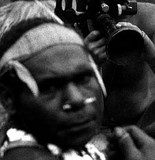Venus and a Cosmic Serpent in Papua-New Guinea
Maurice Godelier (born in 1935), who was the assistant of Claude Lévi-Strauss, is one of the most highly regarded French anthropologists of today.* He wrote anthropological history when he studied a moutain tribe of Papua-New Guinea, the Baruyas, who had been discovered in 1951, having never seen a white man before, and who had known only stone tools until then. He spent seven years with them, between 1967 and 1988. His approach is that of a structuralist, solidly working within the methods and norms of scientific anthropologies as it is practiced today and, of course, would know little of the theses of Immanuel Velikovsky, of catastrophism or of Quantavolution and certainly would have no recourse to them as interpretative tools. * *
*Director of studies at the Ecole des Hautes Etudes en Sciences Sociales, in Paris, after having been at the head of the Department of Anthropology at the Centre National de la Recherche Scientifique and the scientific director of the Musée de l'Homme in Paris.
* * He is nevertheless considered an iconoclast and is no stranger to controversy in his field. Witness his main thesis:
At the foundation of human societies is the sacred
and his four major supporting theses:
1. Some things can be given, some can be sold, some can be neither sold nor given, but must be kept to be transmitted;
2. No society has ever been founded on family and kinship;
3. It always takes more than a man and a woman to make a child;
4. Human sexuality is fundamentally a-social.

I am translating here from his book: Au fondement des sociétés humaines; ce que nous apprend l'anthropology, published by Editions Albin Michel, Paris, 2007 (pp 83-84). The chapter title is:
About things that one gives, things that one sells and those which must be neither sold nor given, but kept in order to be handed down.
(...)My terrain in New Guinea gave me the opportunity to observe frequently to what use sacred objects can be put. Among the Baruyas, a number of clans possess kwaimatnié. These are parcels containing things that one never sees and which are wrapped in strips of red bark, red being the color of the sun. The Baruyas call themselves "sons of the Sun." The word kwaimatnié derives from kwala, men, nimatnié, to make grow. Kwaimatnié are secretly kept in the houses of the masters of initiation of the boys, these men being the representatives of the clans who intervene at different stages of the boys' initiation (which takes ten years, up to marriage). At the age of nine, boys are brutally separated from their mothers and from the world of women and locked up in the houses of the men, which dominate the village. There, they are put in presence of diverse sacred objects - flutes, rattles and the kwaimatnié. They will be taught in due course that the flutes were originally the property of the women, and that one of the men's ancestors stole the flutes from them. As it happens, these flutes contained, and still contain, the power possessed by the women to make children and even to make them without the help of the men.
But what, in the end, is inside the kwaimatnié? I had the honor and joy, one day, to have one master of initiations show to me the contents of his kwaimatnié. I saw inside, wrapped in strips of bark, a black stone and the sharp bone of an eagle, the bird of the Sun. The man said nothing, but I knew, for having been myself partly initiated, that, for the Baruyas, this stone contained something of the powers of the star Venus. Indeed, for the Baruyas, Venus is the metamorphosis of a Baruya woman whom their ancestors of Dream Time had offered, in order to appease him, to the Python Snake, god of rain and of thunder. As for the rattles, they are for the Baruyas objects which the Yimaka, the spirits of the forest, are said to have once granted to ancestors of the Baruyas, and in which are encapsulated the powers of death, of killing prey at hunt or enemies at war.
Within sacred objects, which are the exclusive property of some clans and which only some men are allowed to touch and to handle, two types of power are united: feminine powers, the life powers of which the men are supposed to have exproprietated women in imaginary times, and masculine powers, powers of death and war received directly from the spirits of the forest. But in the eyes of the Baruyas, women remain for ever the owners of the powers of which the men have dispossessed them, even if they have lost their usage. It is for this reason that the men violently separate the boys from the world of women and must initiate them in the secrets of the powers of which they have dispossessed the women. The Baruya men justify this expropriation by saying that the first women did not know how to put their powers in the service of the community. For instance, they killed too much game, and were at the source of multiple disorders. It was necessary for men to intervene and to dispossess them of their powers so that order may reign in society and in the cosmos.
In the end, a sacred object is a material object which stands in for that which is irrepresentable, it throws men back to the origins of things and bears witness to the legitimacy of the cosmic and social order which have succeeded to the times and events of the origins.
A sacred object is not necessarily beautiful. A piece of the "True Cross" is not beautiful. It is more than beautiful, it is sublime. Indeed, a sacred object puts humanity in presence of the powers which order the world beyond what is visible. Sacred objects are not symbols for those who handle and display them. They are lived and thought of as the real presence of the forces who are at the source of the powers contained within them.
The above passage is interesting for every single word which it contains. But let me point out only the most salient information which we are given here: we are astonished (but are we really?) to discover that the most sacred and most secretly guarded objects of one of the last truly "primitive" tribes of the world, the very object which is "neither to be given, nor sold, but must be kept in order to be handed down" refers to planet Venus, in connection with a Python Serpent which is also, from all evidence, conceived of as a redoutable cosmic power and presence in holy Dream Time, that is, at the origins, in illud tempus.
We will go no farther, not ask ourselves if the black stone could be, or evoke, a meteoritic stone, or if the Baruya woman represented by Venus had been a victim of sacrifice, or if the thunder and rain refer to events of a more catastrophic nature.
It suffices for us to recognize in the Baruya story one more guise of a universal story, carried by myth and legends from the Vedas through the Middle East to Precolumbian America of a planet Venus endowed with a tail, or interacting with a heavenly phenomenon interpreted to be a snake, all these pointing to a display which must necessarily have been visible world-wide, and to one or several episodes of a cometary nature which must have involved Venus and which were connected with events terrifying enough for their remembrance to be a founding element, even a justification, for a social order. Little boys are kidnapped from their mothers (and indeed, the Baryua boys may not see their mothers for ten years after having been taken into the community of the men, despite the facts that they live in the vicinity) in order, among other reasons, to be handed down these ancient memories.
Our quantavolutional view of the contents of the kwaimatnié expands their meaning beyond what the structuralist school can conceive of, and brings the Baruyas firmly into our community of shared human memories.

Maurice Godelier

a Baruya

